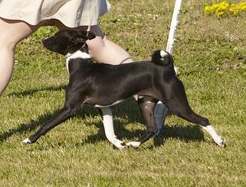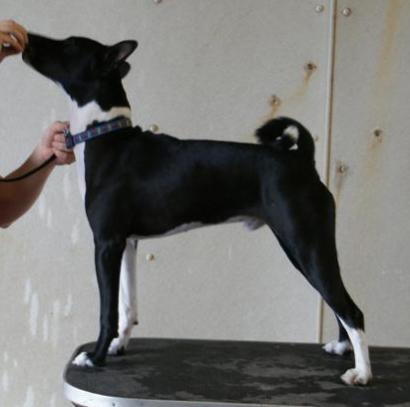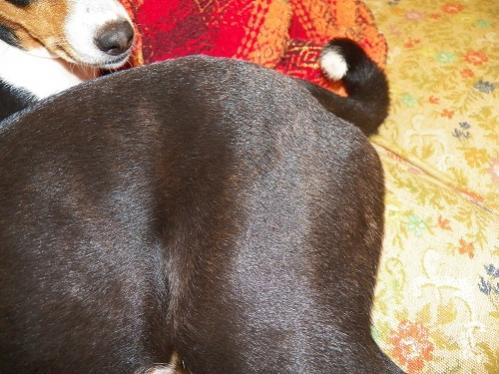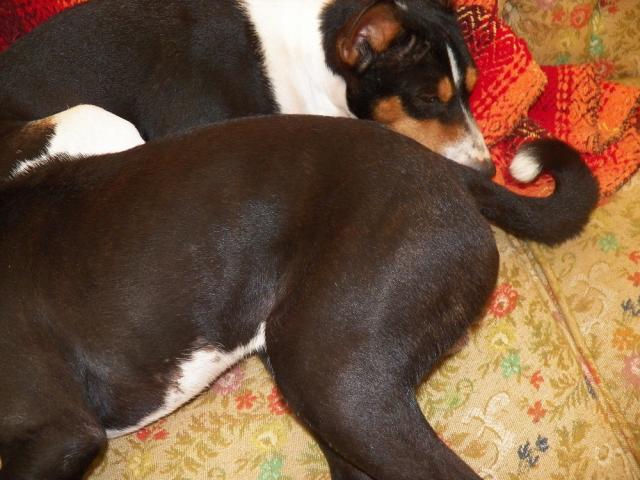Dogo Habari Breeding plans 2012
-
Dogo Habari Basenji's is co breeding a litter with Robyn Dubbert of Sherwood Basenji's. Sherwood's Something Sweet (Sugar is a tri) and Dogo Habari's Man in Black (Johnny is a Black Brindle) have had one breeding. Puppies are expected approximately Dec 19. Black's and tri's are definitely expected. However, there could be other colours.



-
Arlene, looking at Johnny's pedigree there is no way he could be a black brindle. The only brindle in the pedigree is behind his dam's sire. Since she inherited her sire's black, she could not have inherited his brindle, they are inherited at the same loci, so there is no place for Johnny to have gotten brindle. Why do you think that he is a black brindle?
-
I don't know why, but Johnny has brindle in his back end. You can only see it in strong sunlight. No, it's not dead hair, discolouration, or anything else. There are three brindle stripes. Jean Martin and Cheryl Eggerton have seen it and confirmed it. While I won't be able to tell for sure from this litter, I'm sure I will be able to tell down the line when he has other litters. His dam's sire did have a brindle in his first litter out to one of Michelle Barbours dogs. There was a tri, a red and a brindle. I've attached pics, but I don't know if you can see the stripes in the pics.



-
Black and brindle are at the same locus so a dog can only pass on either black or brindle to its offspring not both. The fact that Damisi inherited her father's black means she could not have inherited his brindle and therefore had no brindle gene to pass to her offspring.
I will say that my black and white Sophie has a single clear red stripe on her thigh. It is very clearly red, but she is a black and white and produced two lovely black boys bred to a red and white stud dog. I have also seen black and white dogs with red banded hairs so there is variation in black coats that is not brindling.
-
In my opinion, your argument is flawed. Wili is black, therefore, by your argument Wili could not have thrown brindle either yet he did have brindle boy. This is why I don't post. This is your opinion, based on your understanding of genetics, not mine, nor any of many other people who have bred and seen breeding and genetics far more often and have a history of breeding for 20 or more years. I will continue to monitor this site, simply for my own info, but my opinions do not agree with yours, nor will I post anymore. I was excited about the news, but perhaps my excitement is not worthy of your opinions, since it seems eveytime I post I have negative feedback from a few certain people. Thank the lord that the world is not black and white and exceptions do happen, otherwise we would all have the same outlook. It seems certain people on this site certainly 'run the show.' I have not had one congratulations, only negativity and doubts regarding my opinions as my opinion is always discounted.
-
You are not understanding what I am saying. Wili is a black carrying brindle, he has a black parent and a brindle parent and therefore inherited the black gene from his dam and brindle gene from his sire. When he produces offspring he can only pass on the black gene or the brindle gene to each offspring. If the other parent is red and white then the black offspring do not carry the brindle gene since they inherited his black gene, his brindle offspring did not inherit the black gene they got the brindle gene. This is based on genetic research that identified the location and mutation that causes brindle in dogs, http://www.ncbi.nlm.nih.gov/pubmed/17483404
-
My (admittedly) simple understanding:
Johnny's parents:
Buckwheat = black/white = his genes are black/red - he is not pure for dominant black since he produced a red offspring when bred to a black/white
Damisi = black/white - her genes are black/red - she is not pure for dominant black since she produced a red offspring when bred to a black/white.
We also know Damisi can not carry brindle herself.
Why?
Sire (Wili) is black/brindle (we know this b/c he produced a trindle offspring when bred to a red dam); Dam (Kimaji) is red.
Wili (sire) can only pass along one of his e-locus genes (where black and brindle hang out) either black or brindle can be passed, not both while the dam passes along her red gene.
If sire passes his brindle gene combined with dam's red gene, Damisi would be brindle in color. If sire passes his black gene, combined with dam's red gene, Damisi will be black (black is dominant to red).
To make the gene pair, only one gene can come from Wili - either black or brindle and one from Kimaji - red and we know Damisi is phenotypically a black who has produced both black and red offspring - therefore we can correctly conclude Damisi is a black/red, not a black/brindle/red.
She can not carry the brindle gene which means she does not have the brindle gene to pass on to her son, Johnny.
The end result - Johnny could be pure for black (one dominant black gene from dad, one from mom so no chance of reds.) Or Johnny could be a red factored black, getting one red gene from either mom or dad. Or Johnny could be a red AND tri factored black, getting one red from either parent and a tri gene from either parent since Buckwheat has produced a tri and Damisi has a trindle littermate.
All that said, i DO see what appears to be brindling in his coat, and knowing basenjs, perhaps they have not read the color genetic pages as we have. Far be it for me to ever say never. Only time will tell, assuming enough of a breeding sample is doen. Fascinating color options, even without the brindle in the mix. Good luck with the babes.
-
Thank you Anne, Sugar is with me.
And thank you CongoMama-you understand what I am saying. Damisi produced three blacks and one tri in her litter, but is Damisi a true black? I did not breed her enough to really find out. So, while she LOOKS black, she could certainly be a brindle herself. While they can only pass on one of the genes, could she have been a black brindle (or, as other people could think, a reverse brindle) herself? I never really looked that closely at her. The impossible IS possible. No matter what science states. As Jeff Goldblum stated in Jurassic Park-life will find a way. There are many impossibilities that have happened.
And I do understand what you are saying Lisa, you just don't seem to want to see outside the box. Just because it's on paper, doesn't make it so. Far be it for me to ever be so jaded with life. I look for the -what happens, happens, just deal with it. When something nice happens, it happens for a reason, not to be recorded and dissected as a science project. Science cannot explain everything that happens-otherwise, we wouldn't have miracles.
-
I don't know a whole lot about coat colour genetics in dogs, but have studied it in horses. One thing I have discovered is that there are always exceptions. I have seen "impossible" outcomes from time to time, and of course there are always mutations. Also, our understanding of the way various genes act has changed quite a bit over the years, and we may not yet have it right. It is amusing when an animal genetically tested as homozygous sires offspring that are unexpectedly a colour he can't in theory produce. (not so amusing for the owner who gave a guarantee!) :)
-
To be honest with you, I have no idea what Johnny is genetically. It was once thought that if you breed a black to a tri you could not get red puppies. It wasn't supposed to happen but it was quickly disproven. It was also once thought that breeding a black to a brindle could not produce an offspring that was both black and brindle. This has also been disproven.
Logically, Johnny is either black/black, black/black/tri, black/red, or black/red/tri and should not be able to produce brindles or trindles but as we see in the above examples, there is always a chance logic can be disproven.
-
As I said, as I breed Johnny more, we will see what he produces. Irregardless of his colouring, his reach is excellent as is his movement. He has a good back shelf-not too overdone. I seriously do not like his head, but he is still not fully developed and even lately I notice his head changing. His temperment is great with people and he is a happy, happy dog. His prey drive is extremely high and he is a great racer. Even with just the one breeding I am 99% sure Sugar is pregnant, her nipples have softened (yes, this early, very strange), she wants to be cuddled more and she has less tolerance for the other dogs when she is near me and they approach.
As for the genetics, if science had everything right with genetics, we could, theoretically, use these standards to select the type of children we want including eye colour, hair colour, gender, build, height probabilities and we could also rule out genetics abnormalities. We are definitely not there yet. Case in point is my cousins, the parents had one child with muscular atrophy, after genetic testing, they were told the probabilities of having another child with this were minimal, they had another child and he had a harsher form of muscular atrophy. The second child died when he was two, the first when he was 7. Do you think genetics helped them? Nothing is for sure in this world and nothing, regardless of DNA is proof positive.
-
As I had said, I have seen dominant blacks with some interesting color variation in their black. It is not brindling but perhaps a sabling that causes and intermix of reddish black in the coat. One owner of such a dog noticed that the each hair actually seemed banded with a black and the red black. Another seemed to have a black over coat and a lighter undercoat. In my own dominant black, she seems to have expressed a single stripe of red in her coat so perhaps there is something in those cells deactivating her black gene. So I agree that there is plenty we don't understand about genetics that can cause variations that we don't know how to explain yet but I do think that we have a pretty good grasp of black, brindle, and red and it is exactly as I and then CongoMama explained.
-
I would like to get his DNA colour test done when I have the loot. Going through a separation, trying to sell a house and having a litter is not exactly conducive to having extra money. I know it's not much, but every little bit helps right now. It will be interesting to see what happens and then have the DNA colour test done.
-
As I had said, I have seen dominant blacks with some interesting color variation in their black. It is not brindling but perhaps a sabling that causes and intermix of reddish black in the coat. One owner of such a dog noticed that the each hair actually seemed banded with a black and the red black. Another seemed to have a black over coat and a lighter undercoat. In my own dominant black, she seems to have expressed a single stripe of red in her coat so perhaps there is something in those cells deactivating her black gene. So I agree that there is plenty we don't understand about genetics that can cause variations that we don't know how to explain yet but I do think that we have a pretty good grasp of black, brindle, and red and it is exactly as I and then CongoMama explained.
I have seen some of what you are describing, particularly with this reddish-brown color mixed with the black and usually on the back legs. My b/w bitch has that and has a maternal grandsire that is brindle. However, she also has two b/w cousins with no brindle in their pedigrees (b/w all comes from the same part of the pedigree) which have some interesting reddish-brown coloring in parts of their coat. It's almost seems like they are tri-colored underneath their b/w coats. I've listened to a number of interesting conversations about it between breeders trying figure out where it is coming from. So I'm guessing there might be a number of causal factors that could lead to these variations. If we had more detailed observations of these less obvious variations of coat colorings/patterns for a range of dogs perhaps we could start generating some more solid hypotheses.
-
I have seen some of what you are describing, particularly with this reddish-brown color mixed with the black and usually on the back leg .
A sprinkling on the back of the hind legs can sometimes mean that the dog carries the "fula" gene. I don't think this is the case with Johnny.
A long-time Basenji breeder told me a long time ago that if you can see a reddish cast on a dominant black in bright sunlight then it means it can produce red puppies. I do not know if there is any research to verify this though. I have seen the reddish cast but I have not seen the brindlish cast that Johnny has. It is interesting.
-
I was guessing that the red sprinkling meant they were tri-factored. I know one of the blacks I mentioned is. I'm guessing my b/w might be as her sire is.
visit BCOA on Facebook. http://facebook.com/basenji.org
-
In thinking this through a bit more today, and studying Johnny's picture and seeing stripes (my opinion of course) vs. banding of red hairs or bleed through, as well as pictures of Boston Terriers that look black/white but are in fact brindle, with very little red coming through, one possibility we have not considered is that Johnny could in fact be a very heavily brindled basenji and not black/white as originally thought. Will be even more interesting now to see what he produces in this breeding. Keep the group posted please, Arlene. Thank you.
-
That's the thing with Johnny, he has actual stripes. He has more than you can see in the pictures. He is not as black as some b/w's either. Which, that in itself may mean nothing, but combine it with the stripes and you begin to wonder. Which is why I put in brackets a reverse brindle. If it was mottling or just patches, that was one thing, but stripes are another. I will keep everyone updated. I am sure you are interested, Lisa in what comes out.
